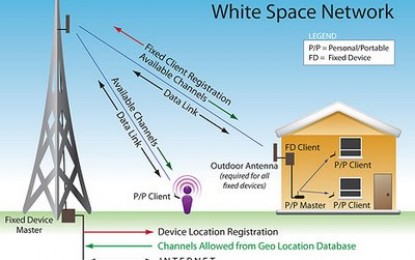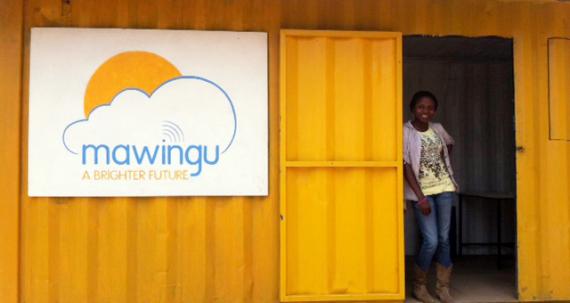Microsoft empowers communities in Laikipia County with TV Whitespace technology

When Kenya’s High Commissioner to Belgium, His Excellency Mr.Johnson Weru watched a video on the Mawingu project and noting that he could not connect with students in Gakawa Secondary School, through a video conference, it dawned on him the value of rolling out technology in rural areas and the great opportunities ICT places to the communities.
This scenario was related to his childhood days as he grew up in Laikipia County without access to electricity leave alone Internet. Decades down the line, it’s a different tale at Gakawa Secondary school which is now electricity lit with solar being for back-up during power surges. The school also now reaps from the advantage of social interaction with other students. The channels have been made available by Microsoft’s 4Afrika Initiative which propels the Mawingu project.
According to the School Principal, Beatrice Ndorongo, there has been notable rise in the mean score from 2.95 in 2013 to 3.46 in 2014 and she attributed this to the support they got from the project as students now have multiple sources of information including the internet through a lab whose construction was supported by Microsoft.
The Mawingu project seeks to connect unserved and underserved communities in rural Kenya. The project utilizes TV white space spectrum to deliver connectivity to solar powered Internet kiosks, or ‘solar cybers’, in rural communities.
“This technology has the potential to deliver on the promise of universal and affordable high-speed wireless broadband for Africa, and we are proud to see that it has started bearing fruit with the improvement of national examination performance at Gakawa Secondary School,” said Louis Otieno, legal and corporate affairs director for Africa initiatives at Microsoft.
So how did the project on TV White Spaces start? On 19 August 2013, the Communications Authority of Kenya issued Microsoft East Africa Limited with a trial authorization to conduct a trial utilizing television white spaces (‘TV white spaces’) technologies in the vicinity of Nanyuki (the ‘2013 Trial Authorization’).
Consequently, a series of pilots and projects were undertaken in defined rural parts of Kenya. These projects relied and continue to rely on a combination of wireless technologies designed to operate on a license-exempt or unlicensed basis, including Wi-Fi and TV White Space base stations and end user devices. To maximize coverage and bandwidth, while keeping costs to a minimum, these radios use several complementary spectrum bands available to license exempt devices, including 13 GHz, 5 GHz, 2.4 GHz, and unused UHF TV band spectrum (also referred to generally and herein as ‘TV white space’).
The TV white space technology is being used for point-to-multipoint “last mile” broadband connectivity. These networks typify the transition from homogenous to heterogeneous networks.
The Mawingu Project currently provides connectivity to the following locations in the Nanyuki area: Kenya National Library Services Nanyuki Branch, Male Primary School, Nanyuki Red Cross Office, Tambuzi Farm, Tithigi Boys Secondary School, Thome Boys Secondary School, Male Secondary School, Gakawa Secondary School, Laikipia County Government Office, Solar Cyber and Cape Chestnut, a restaurant and business centre.
“This project has successfully demonstrated the technical viability of this model of delivery, with interference free point to multi-point coverage of up to 14 kilometres from TVWS base stations operating at only 2.5 Watts power (EIRP measurement),” said Malcolm Brew, Engineer ,Mawingu Project.
In total the project provides approximately 235 Kilometre of TV White Space coverage using multiple 90 degree base station sector antennas. To date, the project has achieved speeds of up to 16 Mbps on a single 8 MHz TV channel at distances of up to 14 kilometres;
Initially, the trial’s main upstream Internet connection was established using fibre provided by Kenya Power Ltd. However, during the course of the project Jamii Telkom Ltd took over once its high speed GPON service was activated. The service delivers a Committed Information Rate of 20 Mbps bursting to 50 Mbps.
A Ubiquiti point to multipoint 5.8 GHz Rocket 5M radio using a 20 dBi antenna at 35m on Kenya Power’s Telecommunications mast provides connectivity to both the Tambuzi and the Cape Chestnut base stations. The project uses a Mikrotek gateway router which in turn is connected to a Meraki MR12 cloud controller where all of the network’s IP addressing is managed via DHCP.
On how the project is sustained, Malcom Brew, explained that schools and public libraries are accessing the Mawingu Internet for free while subscribers are charged Sh80 per week for unlimited usage. “The revenue is re-invested in the project to sustain the networks, “We are not in competition with other providers. We are building the network in rural areas where there is no electricity or Internet connectivity,” Mr Brew added.
TV WHITESPACES AND DIGITAL MIGRATION
In many countries analogue televisions have been switched off and replaced by the more efficient digital television transmissions. This brings in two advantages: freeing up the spectrum for reallocation to other licensed uses and to enable additional further opportunistic access to interleaved spectrum between licensed users.
Will the project be affected by Digital Migration as the project relied on spaces left in between analogue television frequencies? Mr. Louis Otieno, explained that TV White space is also referred to as Dynamic Spectrum Access, which implies that it’s opportunistic.” Even with chances of the spaces being closed on the spectrum, the technology moves to the next space. Chances of the spectrum being fully utilized is next to infinity.”
These UHF frequencies have good propagation and building penetration characteristics making the TV white space suitable for use in rural broadband applications, where transmission links may be several kilometres in length and may involve challenging terrain such as hills, foliage, and water.
Enabling use of TV White Spaces does not need to be tied to the digital migration process and TVWS technology can be utilized before, during and after digital migration. Further, database technology can immediately direct devices to use whatever TVWS channels are available at the time; even as television broadcast stations are being relocated.
THE IKIOSKS UNDER MAWINGU PROJECT

Another notable visit was the Solar Cyber owned by Mr. Benson Maina, a Mawingu agent. Here, services which include Internet access and cell phone and other device charging to his rural community are provided. Opened in November 2013, Maina’s business is located 17 kilometres from the town of Nanyuki. The solar-powered container is the first in what could become a network of containers and other shops across rural Kenya, and hopefully Africa, to provide access to the Internet, electricity to charge devices, and technological expertise and guidance.
Ben’s Community ‘Solar-Cyber’ iKioski is capable of serving up to 8 customers simultaneously from 6 recycled laptops and 2 Samsung Windows 8 tablets, with both the TVWS back haul CPE and Wi-Fi/Hot Spot all running off a small AC/DC 600 watt inverter. With typical duty cycles of usage at the iKioski consuming less than 50% of the average 2.4 KWh of power generated per day, this leaves the balance for phone and torch charging which pays for the leasing/financing of the ‘Solar Cyber’ agency as a local small business.
When he started, Ben didn’t charge for the services offered though currently he charges up to Kshs. 80 per week and Kshs. 300 per month to access services on the ikioski. He has up to 75 people registered to use the service and trains the locals on online outsourcing.
The kiosk also uses the buctify technology to create internet hotspots in Buguret town where they have 5 hot spot centres already and another container in Thome.
Residents of Burguret, Thome and Matanya previously had to commute the 21km paying Sh100 one-way as bus fare to access Internet at Nanyuki town since there were no cyber cafés at the trading centre. They were required to pay up to Kshs. 1 for every minute to access internet but with the ikiosk and hotspot points the locals now get to save on much.
Mr Otieno concludes that Mawingu has had a huge impact on the community already.” Having access to Internet and technology is life-changing – and it’s the way to alleviate poverty. People in the area will begin having incomes as a result of information obtained from the Internet. In a few years, this area will be different from the rest of the country; we will be icons for what’s to come.”
His sentiments were echoed by Smith Brad, Microsoft’s general counsel and executive vice president of legal and corporate affairs. “TV white spaces and efficient spectrum management represent a creative, tested and affordable way of extending broadband access to unserved communities,”
Follow us on Telegram, Twitter, Facebook, or subscribe to our weekly newsletter to ensure you don’t miss out on any future updates.



